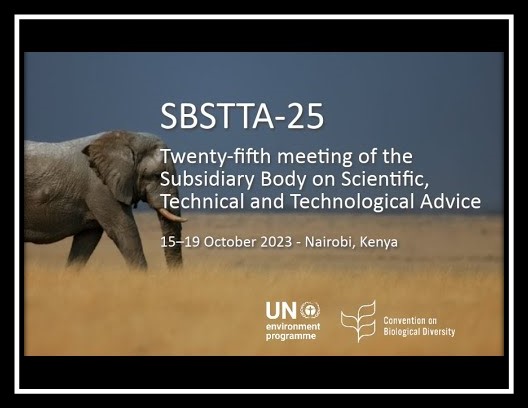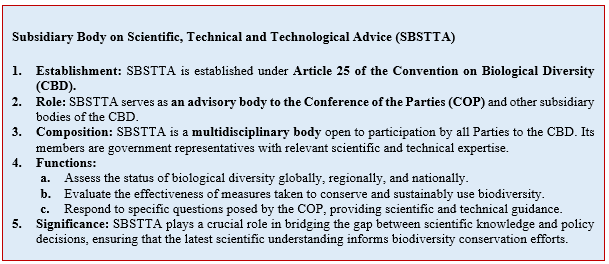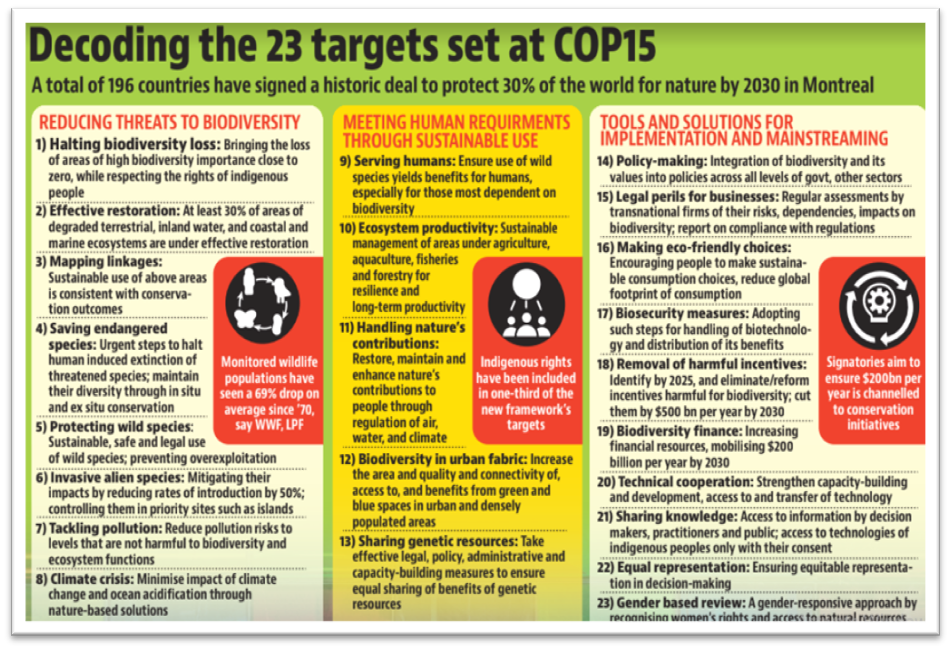- Courses
- GS Full Course 1 Year
- GS Full Course 2 Year
- GS Full Course 3 Year
- GS Full Course Till Selection
- Online Program
- GS Recorded Course
- NCERT (Recorded 500+ Hours)
- Polity Recorded Course
- Geography Recorded Course
- Economy Recorded Course
- AMAC Recorded Course
- Modern India, Post Independence & World History
- Environment Recoded Course
- Governance Recoded Course
- Science & Tech. Recoded Course
- International Relations and Internal Security Recorded Course
- Disaster Management Module Course
- Ethics Recoded Course
- Essay Recoded Course
- Current Affairs Recoded Course
- CSAT
- 5 LAYERED ARJUNA Mentorship
- Public Administration Optional
- ABOUT US
- OUR TOPPERS
- TEST SERIES
- FREE STUDY MATERIAL
- VIDEOS
- CONTACT US
Kunming-Montreal Global Biodiversity Framework
Kunming-Montreal Global Biodiversity Framework
25-10-2023

Context
In October, 2023 the 25th meeting of the Subsidiary Body on Scientific, Technical and Technological Advice (SBSTTA-25) in Nairobi, Kenya concluded.

Recent SBSTTA-25 Meeting About
- This meeting concluded with recommendations aimed at facilitating the transition from agreement to action following the adoption of the Kunming-Montreal Global Biodiversity Framework (KMGBF) in December 2022.
- Also focused on creating a progress monitoring mechanism, while also addressing the implications of assessments conducted by the Intergovernmental Science-Policy Platform on Biodiversity and Ecosystem Services (IPBES) and the Sixth Assessment Report of the Intergovernmental Panel on Climate Change (IPCC AR6), among other matters.
- Other highlights-
|
IPBES Reports on Invasive Species and Biodiversity Valuation |
|
|
IPCC AR6 Findings on Biodiversity and Climate Change |
|
|
Converging Crises |
|
Recommendations
-
- To address these challenges coherently and effectively, the group finalized 15 key points for presentation at the 16th meeting of the Conference of the Parties (COP16) to the Convention on Biological Diversity (CBD).
- This approach aligns with the goals of the Convention, the Kunming-Montreal Global Biodiversity Framework, and other global initiatives such as the United Nations Framework Convention on Climate Change and the 2030 Agenda on Sustainable Development.
- Moreover, the meeting emphasized the importance of utilizing the work of other multilateral agencies, including the World Health Organization and the Food and Agriculture Organization, to enhance scientific and technical guidance in implementing the Kunming-Montreal Global Biodiversity Framework.
Kunming-Montreal Global Biodiversity Framework
- The Kunming-Montreal Global Biodiversity Framework (GBF) was adopted during the fifteenth meeting of the Conference of the Parties (COP)-15 of CBD following a four-year consultation and negotiation process.
- This historic Framework, which supports the achievement of the Sustainable Development Goals and builds on the Convention’s previous Strategic Plans, sets out an ambitious pathway to reach the global vision of a world living in harmony with nature by 2050.
- The declaration made a reference to the '30 by 30' target which is a key proposal being debated at the COP15, that would afford 30% of the Earth’s land and oceans protected status by 2030.
- The framework consists of four goals for 2050 and 23 targets for 2030.
- The Four Goals are: -

- The 23 Targets are:


Must Check: Best IAS Coaching In Delhi



